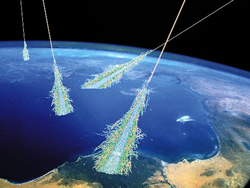|
Cosmic
Rays 
They were discovered when the electrical conductivity of the earth's atmosphere was traced to ionisation caused by energetic radiation. The Austrian-American physicist Victor Franz Hess showed in 1911-1912 that atmospheric ionisation increases with altitude and he concluded that the radiation must be coming from outer space. The discovery that the intensity of the radiation depends on latitude implied that the particles composing the radiation are electrically charged and are deflected by the earth's magnetic field. Scientists have discovered that cosmic rays can effect the earth by causing changes in the weather. Cosmic rays can cause clouds to form in the upper atmosphere after the particles collide with other atmospheric particles in our troposphere. The process of a cosmic ray particle colliding with particles in our atmosphere and disintegrating into smaller pions, muons and the like, is called a cosmic ray shower. About 87% of cosmic rays are protons and about 12% are alpha particles. The light elements compose 0.25% of the cosmic rays. The source of cosmic rays is still not certain. The sun emits cosmic rays of low energy at the time of large solar flares, but these events are far too infrequent to account for the bulk of cosmic rays. If other stars are like the sun, they are not adequate sources either. Supernova explosions are responsible for at least the initial acceleration of a significant fraction of cosmic rays. Supernovas are believed to be the sites at which the nuclei of heavy elements are formed, so it is understandable that the cosmic rays should be enriched in heavy elements if supernovas are cosmic ray sources. However no direct evidence exists that supernovas contribute significantly to cosmic rays.
The most well-known source of cosmic rays is the Sun, with its solar wind. These particles have a characteristic energy limit and so we know that the super high energy ones are coming from something more powerful than our Sun. In 1960 a scientist called suggested that lower-energy cosmic rays come mainly from inside our own galaxy (the Milky Way), whereas those of higher energy come from more distant sources. He expected to see different numbers of low energy cosmic rays coming from various directions at us from within our galaxy because the galaxy is not arranged symmetrically around us. He found that the lower-energy rays had directions are scattered in a similar pattern and his idea was right.
If you live at a high altitude or go up in an aeroplane your radiation dose increases because you are hit by more cosmic rays! If you live nearer the poles you will receive a higher dose of cosmic radiation because the earth surface rotates more quickly at the equator than at the poles… also the atmosphere is deeper at the equator than at the poles.
|
Follow me...
|


 Cosmic Rays are sub-atomic particles arriving from outer space, which have high energy as a result of their rapid motion.
Cosmic Rays are sub-atomic particles arriving from outer space, which have high energy as a result of their rapid motion. 


